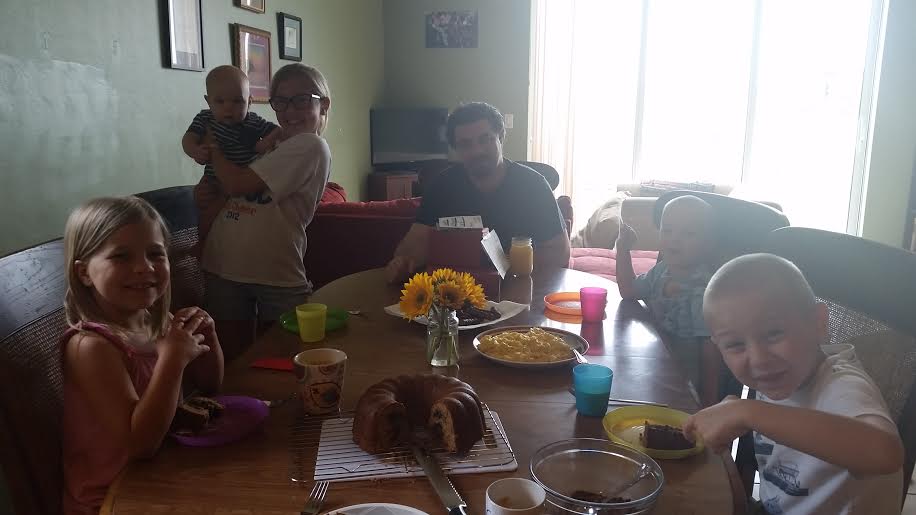First, I’d just like to apologize profusely both to all you reading this, for the abnormal delay in these posts, and to Melanie, whose post was in my inbox promptly after the previous one, perfectly ready to be published. Little Liam came down with bronchitis and our days have been filled with back thumping, breathing treatments, and rocking chairs, so not much time has been left for me to even cut and paste. But at long last, here it is; the wonderful conclusion to Melanie’s three-part series.
I have to say, I’m really glad that Melanie constructed these posts the way she did. Usually, after reading a post like the previous one, I will be all fired up about getting more religious training into my children’s lives, but then I will have no idea where to even start. Often I will feel so lost in our established routine, almost without an entry point to change anything, if you will, that I’ll just give the idea up altogether and feel yet more twinges of Mommy guilt.
I love the practical steps Melanie has outlined here. I’ll be honest, what she calls the “unpopular bit”, the part about not watching TV, certainly was a bummer to me, mostly because it’s something I’ve known we should be working on eradicating for some time. But the reasons she gives here are so crucial to the development of the child’s imagination that I feel that this must be our first step.
I am so grateful to Melanie for these wonderful posts, and I’m also grateful to all of you readers out there who have patiently continued to stop by for the last two weeks in spite of the state of upheaval around here. I’m praying that things will settle into place this week and that I can spend a bit of time blogging, because man, do I have some funny things to tell you. To say that the last two weeks were quite an adventure would be the most massive of understatements. Here’s wishing you all a wonderful Monday, and I hope to be back tomorrow!
***
Forming the Imagination
Where to begin? First, with an idea rooted in Montessori: Children learn through play. Thus a child’s play is work and his work is play. So too children’s worship is also play. A child’s relationship with God is an imaginative act. Thus if you want to cultivate that relationship, you must cultivate his imagination.
So then, how does one cultivate the religious imagination? What kinds of raw materials do you provide your child so that he has an ample toolkit to work with when he enters into religious play?
I have deliberately created an environment that is saturated with our faith. Children learn by their senses. And we can use sensory input to help them know God. Sight, Touch. Smell. Sound. Taste. Woo them with their senses. Give them beautiful things to feed their imaginations and their imaginations will take in what is in their environment and use it in their play. To that end, I’ve filled our house with religious images hung on the walls, with holy cards, rosaries, and statues. To feed their sense of sound I sing hymns while I work and I play hymns and Gregorian chant and other religious music. We connect food and eating with religious feasts. But most of all I’ve invested quite a bit of time and money in building a good library of religious books. Now lest you think I’m all goody two-shoes, we have other non-sacred art on our walls as well, listen to a wide variety of music (jazz and bluegrass, Irish folk music and rock classics and everything in between) and read a very wide variety of books. But I make sure that God is one of the main courses in their daily diet along with everything else that is on their plates.
Shields Up
As much as I think children’s imaginations need feeding, I also think they need shielding. Small children are like sponges and will readily soak up whatever they find. Children at play, they use anything and everything they find in their environment. By listening to the kids at the library or playground, I can pretty much tell what shows and movies they watch. If they watch Dora, they will pretend to be Dora. If they watch Disney movies, they will pretend to be princesses. So I suppose the simplest answer to why my children play at being Mary and nuns is that that is what has captured their imaginations. Since my kids don’t watch television regularly, the most exciting pageantry they have been exposed to is the Mass, the most vivid images are those in their books and those on the walls. I suspect that in an era before television it was more usual for children to pretend Mass and playing at being priests and nuns was not all that uncommon.
Here’s where I might lose some people. For me a huge part of what we “do” is that our kids really don’t do television or movies. If this were a how to book (which it isn’t) this would be the unpopular chapter, the bit of advice that most people skip. And yet when I ponder on what has worked and what hasn’t this seems to be central to why everything else is as effective as it is. Remember this is not about what you should do but it is about what we do and why we do what we do and why I think what we have done works. You don’t have to do the same and I won’t judge you if you do things differently. If tv works for you, go for it. This is just what works for my family.
Now it’s not that we have anything against television or movies. Dom and I watch quite a few shows regularly (and hey, Survivor is on our must-watch list, lest you think I’m all highbrow about it.) No, it’s not that I think television and movies are bad per se; but I do think they are powerful. And especially for young children who are still developing, they have the ability to overpower all other signals. How can pictures on the wall or in a book compete with moving dancing pictures on a screen? How can the pageantry of the Mass compete with the magic of film? I don’t think it can.
When my children are older we will gradually start to introduce them to more television and movies; but I’m not in any hurry. In the first few years especially children’s imaginations are forming and everything that they see and hear, will make permanent marks on their young psyches. My analogy would be one of gardening. In a garden plants compete for resources and if you let weeds proliferate they will take up necessary light and water and space and choke out your fruits and vegetables. I’m very protective of my little seedlings, especially in the spring when we’ve first put them into the beds. However, near the end of the summer when my plants are mature and bearing fruit I am much less diligent about weeding because I know that a few weeds won’t choke them out. Meanwhile I’m perfectly content to let many of the same weeds go wild in the lawn. I actually love dandelions; just not in my garden beds.
Feeding the Senses
So back to how to create an environment saturated with faith. At first it may seem daunting. I’ve tried to include a fairly comprehensive list but please don’t feel like I’m suggesting you do all this at once. This is a list of everything I’ve done over the last five years after all. Pick one or two things and then add to them slowly as you feel ready. I also want to emphasize that none of this need be a big investment of money. For the first year of parenthood my husband was unemployed and since then he’s been working for the Church and we’ve been living on one income. Most of what you need is not stuff but time and attention.
Our faith is incarnational. We encounter God who became flesh in our bodies, we worship him with our bodies. Children especially learn through all of their senses so my approach is multi-sensory and very hands-on.
Teaching by Touch
Touch is so important to small children. It is the primary way in which infants know our love. It is also important in the life of Jesus, who healed with his touch, and in the life of the Church where our priests and bishops impart God’s grace and blessings with the laying on of hands. (On my wedding day my dad lay his hands on my head and gave me his blessing before we left to go to the church.) When my children were baptized we traced the sign of the cross on their heads, a practice we continue to this day. We nurture our children’s faith by cuddling them as we pray, by snuggling them and caressing them during Mass and making it a time when they feel loved.
We also feed our children’s spiritual life with the sense of touch when we help them make the sign of the cross during family prayers and at Mass. From an early age we help our babies to bless themselves with holy water from the font as we enter the church. When the time seems right, when they are starting to reach for things and actively interact with the world we start sticking their little hands in the font and helping them to move them from their forehead to their belly, from their left shoulder to their right. We bought a small plastic bottle to keep holy water in- fill it from the font that they have in the church usually either near the baptismal font or in the rear of the church. When we say prayers at bedtime we bless the kids with holy water and help them to bless themselves. In this way I help them to pray their first prayers with their bodies long before they learn to pray with their words. Long before they are even capable of words.
We let them hold rosaries, we let them touch the crucifix, we let them play with holy cards. When they were toddlers I helped them to kiss the crucifix at bedtime, lifting it down off the wall and letting them hold it and kiss it. We collect cheap plastic rosaries and we let the kids drag them around the house. Mind you, I’m terrible about actually praying the rosary. But I think that nonetheless they are a part of the fabric of the children’s lives and have helped make faith a part of their daily experience.
The Odor of Sanctity
I don’t have a whole lot to say about smell. While the Church does use smells such as incense, chrism oil, flowers, they aren’t much of a part of my domestic church—at least not yet. But what mother doesn’t know and love the smell of the holy chrism oil that is smeared on her baby’s head at baptism? It just smells like holiness! I always do make sure the older children get to smell it when we have a new baby baptized. I do have a small vial of blessed oil a dear friend sent me right before Anthony’s birth and I have used to bless the children when they are sick. But smells certainly can be an important tool in the domestic church. I know families who burn incense in front of icons, use beeswax candles, etc. It isn’t part of what I do though it is a part of what I’d like to do in the future.
Songs that Lift Our Hearts to Heaven
I can’t sing well. I can’t read music. I even stopped singing at all for a long time because of a few hurtful comments about how I am not able to carry a tune. And yet motherhood changed me and I found myself singing to my babies to help them sleep. Sure enough among my repertory of songs that I can sort of sing with a noticeable tune are various hymns. Especially the old fashioned hymns that can easily be sung without accompaniment. The ones our former pastor used to sing at daily Mass where there was no cantor, no one to play piano and we just had to provide our own music.
Amazingly, my children like it when I sing to them. Even more wonderfully, they have learned how to sing all the hymns that I sing. At one point when I was pregnant and too tired to pray, I realized that singing hymns was a form of prayer. And so I began to be more deliberate in my singing. I started printing off lyrics and posting them on my kitchen cabinet doors so that I could learn them while cooking and doing dishes. Now I make a point of singing as I go about my housekeeping jobs. I sing when I make the bed and I sing while I fold laundry and I sing when I do dishes and when I’m cooking dinner.
Every night I sit in the dark after I’ve tucked them in and I sing the girls lullabies. I sing Amazing Grace and Immaculate Mary and then a hymn that fits the liturgical season, Silent night at Christmas, Parce Domine during Lent, Regina Caeli at Easter, something else during Ordinary Time. Yes, my children are now able to sing the Regina Caeli in Latin.
The Family Art Gallery
People hang pictures of their children on their walls. Photos of relatives. Reproductions of Monet’s water lilies. What you hang on your walls means something and to small children, who are very visual, they can convey a strong message. We have some pictures of family. We have a few images of places we’ve been on vacations. Some images of flowers and the like. But for the most part the art we hang on our walls is religious art. This was a conscious decision on my part not only because I find it to be beautiful; but also because I do believe that religious art serves a didactic function.
I think children absorb the unspoken message about what you hold dear by what you hang on your walls. Our walls say that Jesus and Mary and the saints are an important part of our lives. I’ve made a point of hanging a crucifix above each child’s bed and beginning them on their own collections of images of Mary and their patron saints. I’ll come back to the idea of celebrating their baptismal anniversary and the feast days of their patron saints. Here let me just say that those are perfect opportunities for growing their collection.
If money is an issue– and I’ve been there—then images might be as cheap as holy cards, which usually run from seventy-five cents to a dollar. If you can’t find a holy card of their patron saint, then maybe you can find an image of the saint online and print out a nice copy. If you put it in a pretty frame it will look real enough to a small child.
But don’t stop at hanging them on the walls. Point to them and use them as an opportunity for prayer. Once a day or every time you walk by, whenever you think of it: Jesus, I love you. Holy Mary, pray for us. Cultivate the habit in yourself and soon the kids will follow suit.
Picture Books
I could write an entire blog post just about our favorite religious picture books. There are so many beautiful stories of saints, retelling of Bible stories, books about Jesus and Mary. I buy my kids books for their birthdays and for Christmas and I usually (though not always) include at least one religious picture book from the long list of recommendations that I’ve picked up here and there on various blogs. (Amazon is great for keeping track of books I want. I’ve been compiling my wishlist of children’s books for about six years now and I add more than I buy so there are always plenty of ideas on it. To me it makes sense to spend money on these books above all because they are the ones that our public library is les likely to carry and because they are the ones I want my kids to read over and over and over again until Jesus and Mary and the saints feel like good friends.
The Liturgy of the Hours with Toddlers
You don’t have to pray the Liturgy of the Hours—though the Church does encourage all lay people to do so; but it’s what I do and it’s been the best thing for praying with my children.
Luckily, I’d been praying the Liturgy of the Hours for a couple of years by the time I was married and so had already developed the habit when children started coming. I have had many lapses where I stopped praying it for days, weeks even. But it always pulled at me, like there was a big hole when I wasn’t praying daily and I always come back to it. The Liturgy of the Hours grounds me as nothing else can. So one way or another. I was determined to keep it up. I have experimented will all sorts of ways of working it into my days with kids. I’ve prayed while nursing, balancing the book on the arm of my chair or propping it on a pillow beside me on the bed. Sometimes I read it out. Sometimes I’d just pray silently.
When Bella was a toddler sometimes praying aloud would draw her to my side. Then she’d want to pull out my growing collection of holy cards. I didn’t want my fragile paper cards to be destroyed so I bought a dozen or so laminated cards, picking some of my favorite saints and beautiful images of the crucifixion, Madonna and child, etc. I’d dole them out one by one as I prayed. Over time this developed into a little litany of the saints. I’d hand her a holy card of St Therese and say “St Therese, pray for us.” She began to echo this and soon we’d be praying together. Sometimes that litany of saints with holy cards would supercede the Liturgy of the Hours, sometimes it would be a brief interruption and I’d return to my prayers. As she got older Bella even began to join in with some of the antiphons and responses of the office while Sophie and then Ben took over the holy card stash.
I think it worked so well because I had no expectations. I never insisted that she pray with me—but I also never pushed her away. (Well, almost never. We all have our bad days, don’t we?) Instead, I simply went about my prayer while inviting her in, being very responsive when she did join me, telling her “Thank you for praying with me,” and making it a positive experience for her
I don’t want anyone to build up a false image that my kids pray with me all the time or even a majority of the time. Just that it happens. And I think it is good that it does.
Name Day Celebration
We don’t do a whole lot; but I like the idea of marking the feast days of the children’s patron saints. We’ve given them a small present: a holy card, a small medal or crucifix, etc. We’ve had a treat like cookies or a cake. We’ve gone to daily Mass.
I do try to emphasize each child’s patron saint, tell them stories about their saint, find a book if it’s available. I’m even tempted to make my own book, a compilation of the stories of all our family’s patron saints. I want my children to think of the saints as their friends.
Baptism Day
We keep this simple as well. I bake a cake. We might go out for a special dinner. We might go to daily Mass. (Last year after Mass we asked Father for a special blessing for the girl whose baptism day it was. He was delighted and did a wonderful job improvising a blessing and then gave them each a holy card from a pile he had in his office.) I give them a small present. After dinner before we have dessert, I light their baptismal candle and we renew our baptismal promises and sing a hymn. Then they get to blow out the candle.
Celebrate the Liturgical Year
There is so much I could say about celebrating the liturgical year. It could be another series of posts. But I’ll just give one example and leave it at that. Nothing has captured my children’s imaginations more than the Nativity scene at Christmas. I am so glad that we have the unbreakable resin set that I can let the children play with because I think that hands on interaction is so effective at allowing them to really absorb the story. When I set out the Nativity for the first time, I read the story and sort of act it out with the figures. I hold the angel and have it speak to Mary and then to Joseph. The shepherds come to the manger followed by the sheep. After that I usually step back and watch them play. Not all their games are acting out the Nativity story. (“This sheep is called poop.”) Sometimes it’s just imaginative play with other story lines. Tea parties, train trips and the like. But even that sort of play, I think, gives them an entry into the story of God who became Man and dwelt among us.
An Elephant Named Dad
I don’t really have a conclusion because I’m not done learning. Every day is a new adventure in parenting. Mostly our days are filled with the imaginary adventures of Johnny Pat Snuff, Cranna, Afadilla, Princess Rose, Gina, Jane, and “Some Other Girl,” two horses names Sly and Slyer, and an elephant named Dad. But sometimes the cast of characters includes Jesus, Mary, St Francis, St Peter, St Therese and various nuns. The religious play is a thread that weaves in and out of our lives. One minute they’re kneeling in prayer around the coffee table the next Sophie is hitting Bella over the head with a block. Where it will end, God only knows.











